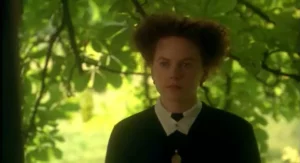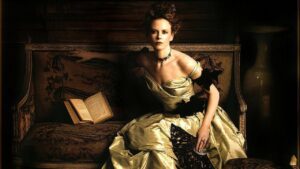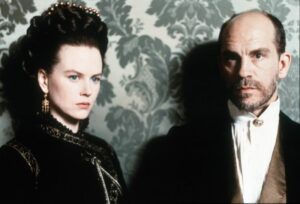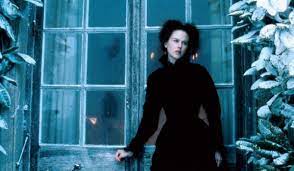“The Portrait of a Lady” – Femininity in the Shackles of Tradition and Convention

Title: “The Portrait of a Lady”
Release Date: 1996
Director: Jane Campion
Cast: Nicole Kidman, John Malkovich, Martin Donovan, Barbara Hershey, Viggo Mortensen, Valentina Cervi, Christian Bale, Richard E. Grant
Jane Campion’s film based on Henry James’ novel, “The Portrait of a Lady”, is a complex portrayal of womanhood trapped in the confines of patriarchy. It is a story about the brutally stifled dreams of a young girl who is curious about the world. At the same time, however, “The Portrait of a Lady” is also a story about the fact that the road to maturity leads through suffering, which, although it does not ennoble, brings with it a deep knowledge of the world order and one’s own nature.
“The Portrait of a Lady” – “A woman is nowhere at home”
“The Portrait of a Lady” is set in the 19th century, but Jane Campion gives her heroine completely contemporary features and builds a clear bridge between her story and the fate of women living today. Isabel Archer (played by Nicole Kidman) is a young, educated maiden who arrives in Britain from America at the invitation of a wealthy aunt. The trip provides her with a wonderful opportunity to get to know the old continent. For, as it turns out in one of the first scenes, Miss Archer is a modern woman who dreams of traveling and developing her talents. For this reason, she rejects the advances of the wealthy Lord Warburton (Richard E. Grant), for she is aware that marriage brings with it serious limitations for a woman.
It soon turns out that not only the aristocrat was disappointed in his feelings for Isabel. The attractive girl also rejects Caspar Goodwood (Viggo Mortensen), who is in love with her. She even tells him that if he ever heard that she was getting married, it would certainly be a lie. Fascinated by Isabel’s courageous attitude, cousin Ralph (Martin Donovan), decides to make her a gift – he persuades his dying father to bequeath the poor girl a substantial sum that will enable the heroine to realize her dreams.

When Mme. Serene Merle, who is staying at the Touchett home, learns that Isabel has gained a fortune, she gets the idea to get to know her with her former lover, Gilbert Osmond (John Malkovich). The girl, fascinated by the personality of the unconventional art expert living in Florence, quickly falls into his trap. She marries the aristocrat and becomes stepmother to his daughter Pansy. It soon turns out that Isabel has fallen into a trap – for she becomes completely dominated by her psychopathic husband. For this reason, when one day she receives news of the serious illness of her cousin Ralph, she decides to seize the opportunity at all costs and against her husband’s wishes leaves for England.
Thus, the portrait of a lady has a buckle composition: time comes full circle when Isabel arrives at the English Touchett estate for the second time in the finale. This treatment allows us to reflect on the transformation of the main character, which takes place during the long journey. The young American woman experiences European life and realizes her own inadequacy to social rules. This foreignness gains an additional dimension in the film, which is aptly captured by Madame Merle – “a woman is nowhere at home. She has to keep herself afloat everywhere.” Jane Campion, like, for example, in “The Piano”, then shows woman as the Other in a world arranged by men.
The film “The Portrait of a Lady” – Isabel’s metamorphosis
“The Portrait of a Lady” interestingly depicts Isabel’s metamorphosis. This transformation takes place both physically and personality-wise. At first, the heroine gives the impression of a lively, cheerful girl, whose freedom is reflected in her unruly hair and modest, unrestrictive dress. Marriage to Osmond leads to a visible transformation of Isabel. She becomes the titular “lady” wearing magnificent fashionable clothes and carefully pinned up hair. It is significant that the appearance of the heroine is deceptively similar to the image of Serena, who has a great influence on Isabel.
Nevertheless, with the achievement of the perfect image, Ms. Osmond’s girlish naturalness completely disappears. The tightly fitted outfits give the impression of a tight armor restraining the owner, and the long train of the dress clearly impedes her movements. Jane Campion emphasizes this feature of Isabel’s outfit by using slow-motion close-ups directed at the tail of the heroine’s skirt. Also, the woman’s new elaborate hairstyle is even striking for the heaviness of the updo – the locks wrapping around her head even recall a crown of thorns, especially in the scenes when a tired Isabel tilts her head and tries to massage her sore temples.

Therefore, the status of the title lady involves great sacrifice and, moreover, the loss of her own individuality. Isabel’s perfect superficiality makes her one of the expensive pieces in Osmond’s precious collection. The heroine fits perfectly into the tastefully decorated interior of the Italian aristocrat’s home. The woman’s gradual loss of individuality is symbolized by the changing color scheme. Indeed, vivid expressive colors give way to faded pastels and then sepia. A foreshadowing of the heroine’s objectification is already provided by the scene in the basement of the Italian museum, in which Osmond plays with Isabel’s umbrella. It is repeated in the heroine’s dream, when her naked figure is pulled into the whirlpool of the umbrella spinning in Gilbert’s hands.
“The Portrait of a Lady” – a woman triple trapped
“The Portrait of a Lady” is an image of a woman trapped in the roles imposed on her by the patriarchy, especially in her function as a wife completely dependent on her husband’s will. Signs of this enslavement are visible not only in the sphere of the aforementioned appearance of the heroine, but also in the creation and filming of space. While at the beginning of Jane Campion’s film we have to deal with beautiful open air – such as the opening scene in a sunny, green garden. While as the plot develops, the space becomes more and more enclosed and bleak, until finally it is limited to the dark interiors of Italian houses. In frames composed in this way, Isabel somehow melts into the background, one gets the impression that she is part of the Osmond clan’s painterly portraits.
The main character’s entrapment is particularly emphasized by the scene in which she enters her husband’s house from a sunny street. The moment Isabel crosses the threshold we watch in slow motion. We see on the screen a heavy door that slowly closes behind the woman, gradually hiding her face in the growing darkness. This is paralleled in another scene – when Pansy refuses to walk with Isabel. Osmond’s daughter weepingly stops at the shadow line – because she claims her father doesn’t allow her to go out in the sun.
The character of Pansy (Valentina Cervi) plays an important role in “The Portrait of a Lady”, as she shows the social enslavement of womanhood at the stage of adolescence. Raised in a convent, the girl is a downright captive object in the hands of her despotic father. As an adult maiden, she never opposes his will, and when he demands the rejection of the young man with whom she is in love, the girl does so without a shadow of rebellion.

The character of Serena, on the other hand, reflects the situation of a mature woman. This heroine has almost tragic features – despite the fact that she is the cause of Isabel’s misfortune, she herself deserves sympathy. In her youth, she was unable to face social conventions, and when she gave birth to an illegitimate daughter from her relationship with Osmond, she agreed that she should be considered the child of her lover’s deceased wife. In doing so, she relinquished her parental rights and left the girl to the mercy of the psychopathic Gilbert. Jane Campion’s movie therefore depicts women’s entanglement in roles imposed by the male order at three stages: childhood, youth and maturity.
“The Portrait of a Lady” – suffering as a path to self-awareness
Despite its pessimistic conclusions about the social and familial position of women, “The Portrait of a Lady”, directed by Jane Campion, offers hope for a change in women’s destiny. Here the director makes a significant change from the literary original. This is because in James’ novel Isabel, after the death of her cousin, returns to her husband and acts as a good wife. Campion’s film, on the other hand, ends with the heroine far away from Osmond, in England, and is yet to make a decision about her future.
The compositional buckle of “The Portrait of a Lady” closes, the heroine finds herself in the same place as at the beginning, only that she is richer with all her baggage of experiences. The symbolic cycle of nature also closes – at the beginning it is spring, in the finale the garden sinks into winter scenery. Isabel in the place where she rejected Lord Warburton’s advances years ago, and this time she rejects a man – Caspar Goodwood. While she momentarily succumbs to passion and a vision of a life together, she eventually pulls herself out of her suitor’s embrace and determines that she will direct her own fate.

Painful experiences allow the heroine to gain a deep knowledge of the world and what she really wants and doesn’t want. Suffering becomes a source of self-awareness and a path to a woman’s inner maturity. Isabel gains the courage to become the woman she really is. She wants to decide her own life, even if it means rebelling against social conventions. Its clear foreshadowing is the moment when a changed Isabel, resembling herself from years ago, disembarks from a ship in England and goes against etiquette. When asked how the voyage went, she initially mechanically answers that it went well, but later states that this is not true and the road was terrible.
“The Portrait of a Lady” – a lady in the present day
One might think that a story set in 19th century realities has little to do with the present day, and that the emancipatory problems of the heroine are long gone. Campion, nonetheless, builds a clear reference to the present in the opening shots of “The Portrait of a Lady”. At first we see a dark screen and hear the confessions of the girls as they talk about their dreams and first love experiences. After a while, it turns out that they are contemporary teenagers, and the title of the film is written on the hand of one of them. The director then suggests that gender stereotypes and social patterns are still a limitation for women. And the realization of dreams and freedom in love are sometimes particularly difficult for women to achieve.
Literature:
M. Radkiewicz, “W poszukiwaniu sposobu ekspresji. O filmach Jane Campion i Sally Potter”, Kraków 2001.
